When levelling up your music production, the importance of a decent set of monitors cannot be underestimated, since their role in accurately transmitting the sound from the outputs of your interface across the room to your ears makes them as vital a link in the chain as the interface itself.

A good set of monitors should be the audio equivalent of a mirror – what you hear should be a true representation of what’s actually there. The more accurate the response, the more likely it is that, if it sounds good to your ears, itwill sound good to everybody else as well. The question is, what are you looking for in the ideal project / home studio monitor if your main output is electronic or computer-based music?
Monitor selection is a very personal thing – what works for one person may not work at all for another. You’ll be looking for something with a compact footprint that can be positioned fairly close to a wall without compromising the bass response, a deep bass extension for those kicks and sub basses, coupled with a non-flattering, even response across the mids and crisp, detailed highs. You want a monitor to accurately reflect the changes you’re making to your mix, the ultimate aim being to produce an end result that sounds good when played back in any environment, from your car, to the club, to the Bluetooth speaker you’re playing your iPhone through at your mate’s barbecue.
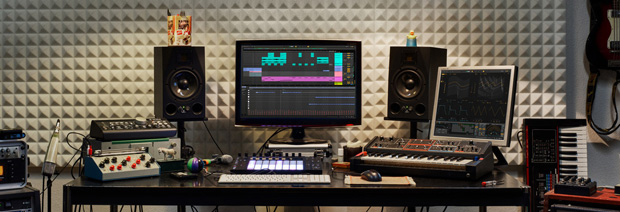
Monitors that exhibit a so-called ‘smiley curve’ response, with exaggerated bass and top-end responses designed to flatter the sound, may sound good while you’re working on them, but the end result is likely to be a lacklustre mix lacking in lows and highs. After all, while you’re working on your project, it’s what you hear with your own ears that steers the decisions you make when it comes to cutting or boosting certain frequencies and levels. So if your monitors are colouring the sound and making it sound more punchy, bottom-heavy and sparkly than it really is, you’re going to end up disappointed when you play your mix elsewhere.
“A good set of monitors should be the audio equivalent of a mirror – what you hear should be a true representation of what’s actually there.”
The difference, then, between studio monitors and the consumer speakers that might come with your hi-fi or computer, is that studio monitors are designed to reproduce audio frequencies as accurately as possible across the audible frequency spectrum, ideally at any volume level. While a totally flat response across the frequency spectrum is the Holy Grail of monitor manufacturers, it’s an inescapable fact that all monitors will colour the sound in some way. It can take a while to get used to the particular characteristics and sound of one set of monitors over another. The longer you use them, the more you get to know the quirks in their response curves and tailor your production decisions accordingly to ensure the best end result.
Achieving such a flat response can come at a cost, however, as it tends to take quality materials, high-end electronic components and well-executed design and engineering to pull this off, which is why a decent pair of monitors can be a bit on the pricey side. However, there are still plenty of options available that are capable of delivering more than adequate performance for those on a tighter budget.
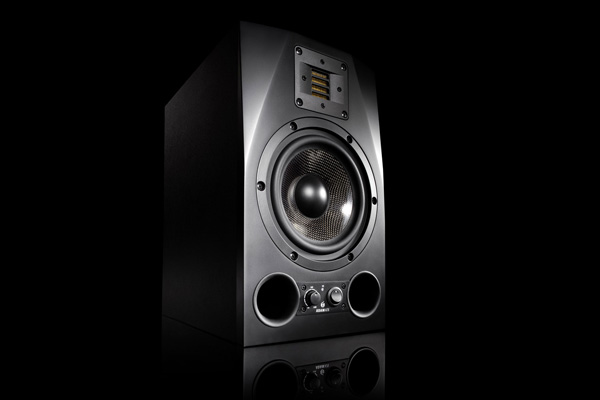
Speakers corner – the evolution of the modern monitor
Before the advent of tape recorders, most commercial recordings were cut live to a master disk, often in a single take and with no editing. Because of this, there was little or no real need for accurate monitoring, as playback scenarios were few and far between. With the advent of tape recording, multitracking, overdubbing and mixing however, there came a heightened requirement for being able to focus in on the detail of what was being recorded and played back after the event.
Up until the late 1960’s, studio monitoring systems tended to consist solely of large, wall-mounted units with huge cones for the low frequencies and concentrically-mounted midrange cones or horns. Each component was fed by a crossover unit that split the incoming signal into the required frequency bands, usually at around 1000-1200 Hertz, so that the low frequencies were sent to the bass cone and everything else to the midrange unit.
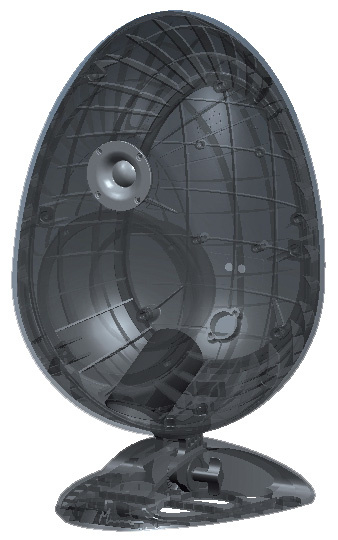
The MunroSonic Egg 150
By the 1970’s, however, studio technology had progressed to the point where nearfield monitoring was becoming more widely used, driven in part by the BBC’s need to monitor in the vans they were using for outside broadcasts at the time. The BBC’s LS3/5A and JBL’s 4310 compact nearfield monitors brought about a revolution in studio monitoring. These units were compact enough to be placed on the top of the mixing desk and could be listened to at much closer distances than their wall-mounted cousins. They also allowed the engineer to focus more on the sound coming directly from the speakers, rather than that being reflected off the walls and ceiling. So began a trend that has lasted up to the present day, the technology having progressed over the intervening years to the point where most ‘nearfield’ studio monitors are compact and affordable enough to bring professional-level performance within reach of the budget-conscious home recordist / producer.
Key features to consider
As always when purchasing any piece of recording gear, there are several factors that can influence where your money goes. Here are just a few of them…
Active vs passive
Passive monitors by definition need to be connected to a compatible power amp in order to work – a notable example is the famous Yamaha NS10, the iconic, white-coned nearfield monitor that dominated the professional studio market in the 80’s and 90’s, whose perfect partner was the famous Quad 405 power amp. The one main advantage of this approach was the versatility it afforded to customise your system – changing the amp could have a major effect, either detrimental or beneficial, on the sound of your monitoring setup. It also meant that the speaker units themselves were lighter and therefore easy to set up and move around.
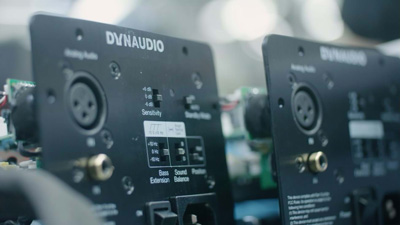
These days, thanks to the progress made in the miniaturisation of electrical circuits and components required in loudspeaker design in general, most nearfield monitors are of the active type; i.e. they don’t require external amplification because all the necessary amps and crossovers required to drive the conesare built into the speaker casing along with the cones themselves. This is more convenient not just because the units are self-contained, but also because you don’t need to shell out an additional arm and a leg for a compatible power amp. Most active monitors also offer some form of adjustable room response compensation features, achieved by the use of internal digital signal processing chips (DSP) that can be a bonus when setting up and adjusting to your unique monitoring environment. You will, of course, require a power lead (and a mains socket of course) for each speaker, but that’s not really an issue in most modern studio environments. So because the vast majority of monitors on the market today are active designs, unless you specifically want to go the passive route, this is largely a decision that has already been sorted for you by the manufacturers.
Reflex / Transmission line
Smaller speakers are always going to struggle more to accurately reproduce bass frequencies than larger units, simply because of the wavelengths of low-frequency soundwaves. One way in which designers have sought to get around this is by building bass ‘ports’ into their speaker casings, an approach known as reflex design. These are specially designed ‘tunnels’ within the casing that exit via a hole – a bit like an exhaust pipe – somewhere in the casing of the speaker unit. If the bass ports are located on the rear of the cabinet however, this can cause issues with positioning of the monitors close to a wall.
A variation is the transmission line design, which gets around this problem by incorporating a sort of long, folded tunnel structure, lined with absorbent acoustic material, into the innards of the cabinet to handle the bass response, often terminating in the front of the speaker. This can significantly reduce low frequency distortion and deliver greater bass extension and loudness than a ported or sealed design of a similar size, meaning that you don’t have to crank the volume to elicit the correct bass response – the response is balanced whatever the volume level.
Frequency response
A good set of monitors with a so-called flat frequency response should theoretically give you the ability to reveal detail and make mix decisions such as subtle changes to EQ and compression more easily. The spec sheets will usually quote a range of frequencies that the speakers are able to reproduce, which will usually exceed those frequencies audible by the human ear, normally around 20Hz – 20kHz. Many monitors also offer options for tuning the frequency response of the monitors to match the acoustics of your studio space – this is done by the addition of digital signal processing (DSP) circuitry, which in turn requires internal analogue-digital-analogue (ADA) converters, the quality of which can have a big effect on the overall sound.
Woofers and tweeters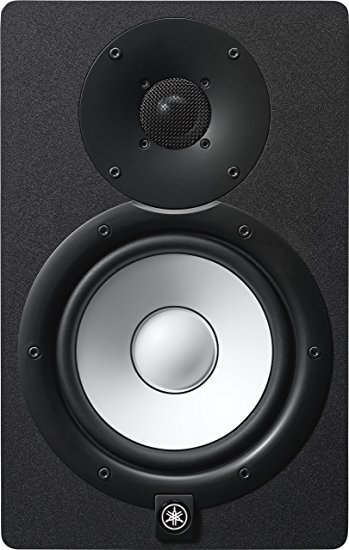
One thing that all the monitors on our list have in common is that they all have multiple drivers. In other words, each speaker unit has at least two cones, one large one (or ‘woofer’) to handle the bass and lower-mid frequencies, and a small one (or ‘tweeter’) to take care of the upper mids and highs. In an active monitor, the incoming audio signal is split into two frequency bands – low and high – by a component called a ‘crossover’. The point at which the split occurs is known as the crossover frequency, and this varies greatly from monitor to monitor, anywhere from between 800Hz-2kHz. The low-frequency signal is then sent to the woofer and the high-frequency signal to the tweeter, each via its own power amp. The fact that each driver has its own amplifier is often what contributes to the surprising weight of an active monitor!
Ear Fatigue
Mix sessions can last for hours at a a time, so one very important thing to consider when choosing studio monitors is so-called ‘ear fatigue’, which essentially translates into how long you’re able to listen to them at a decent working volume before your ears start to get tired. A revealing sound is all well and good, but if this results in a sound that’s too harsh and unforgiving in the midrange, say, your monitors will be challenging to listen to for any great length of time. Because everyone’s ears are different though, one man’s sonic silk purse may be another’s sow’s ear, so the fatigue factor is something very subjective that’s going to be very hard to gauge without a thorough test of the speakers you have in mind. So if at all possible, try to get hold of a pair to ‘test drive’ for a while, so that any long-term compatibility issues between the speakers and your ears can be assessed. You’ll find it pays dividends in the long run, as you’re more likely to end up with a monitoring system that’s right for you, in that it’s effective and comfortable to work with for long periods.
Sub or no sub?
While perfectly capable as functioning as a stereo pair with good performance across the entire frequency spectrum, many monitors currently on the market are available as so-called 2.1 systems, consisting of two nearfield, desk-mounted stereo speakers to handle the upper and mid-frequency ranges and a separate, single sub-woofer, usually placed somewhere below the desk, to handle low frequencies. Because the sub is usually a large unit containing a large diameter cone, it’s often able to extend the low-frequency response of the system down to around 20Hz or so – the kind of bass you feel in your chest rather than hear. While this may sound great and reveal a lot more low-end detail than a solitary pair of desk-mounted nearfields, in small rooms the extended low-frequencies can create noticeable peaks and troughs in the bass response. For that reason, we’ve predominantly focussed our list on stereo systems, but highlighted whether or not a compatible sub-woofer is available from the same manufacturer.
10 Best Studio Monitors – Buyers Guide List 2017
So now onto the list of what we consider to be ten of the best studio monitors on the market today. Like all of the lists we feature on GTPS, we don’t believe it’s particularly useful to say that one device we’ve included is categorically better than another, and neither is this a categorical list of the ten best monitors available. Monitors are a very personal choice, and in this roundup of some of the market leaders we’re simply highlighting some of the best options currently available for various budgets and studio setups – everyone will, of course, always have their own personal favourites.
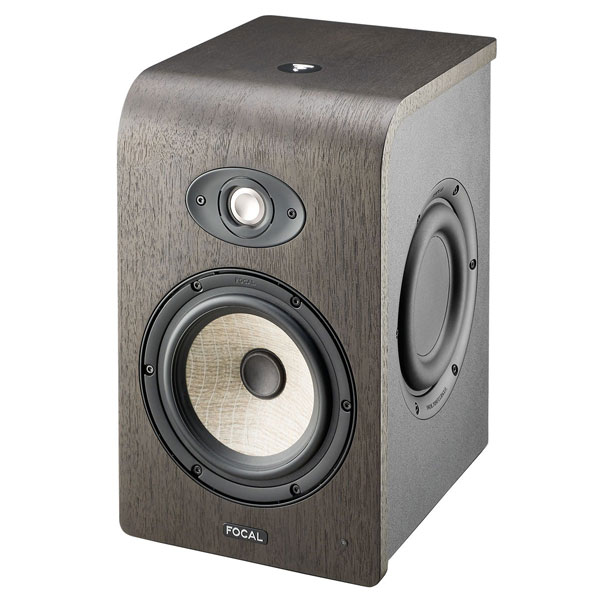
1. Focal Shape 65
Focal’s Shape range of active monitors replaces their acclaimed CMS series, and is available in three sizes – the 40, 50 and 65, in order from smallest to largest. The largest of the range, the 65 is designed with a sideways-facing, 6.5-inch passive radiator cone – in essence an unpowered speaker cone that reacts to the sound pressure inside the cabinet. This dismisses the need for a bass port, the idea being that this makes it easier to position the monitors with their backs next to a wall, a commonly-required configuration compromise in a lot of small studios. There’s also low tweeter directivity, meaning that it’s not so essential to have the speakers placed at one particular optimal angle for best results. Sound-wise, with a variable crossover set at 160Hz and adjustable low and high frequency settings to optimise the response to their surroundings, the Shape 65 offers great performance for the price, and as a bonus the cabinets include built-in threaded holes so the speakers can be wall or ceiling-mounted using an optional accessory mounting kit.
Focal Shape 65 – Specs:
Design: 2-way active, with side-mounted, 6.5″ double passive radiator
Woofer: 6.5-inch Flax sandwich cone
Tweeter: 1-inch ‘M’ profile Aluminum-Magnesium dome
Frequency response: 40Hz – 35kHz
Wattage: MF/LF 80W, class AB, HF 25W, class AB
Dimensions: 14 x 8.6 x 11.2″ (355 x 218 x 285mm)
Weight: 18.7lb (8.5kg)
Compatible Sub? No
Check current price: Guitar Center, Musician’s Friend.
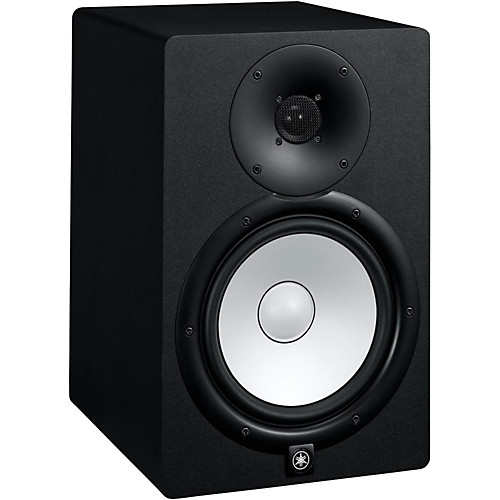
2. Yamaha HS7
Yamaha all but cornered the nearfield market back in the 80’s and 90’s with its legendary NS10M monitors. In a matt black wooden casing with a distinctive white bass cone, they came to be the monitors of choice for a huge percentage of studios worldwide, thanks to their uncompromisingly accurate response. The NS10M was discontinued by Yamaha in 2001, but its DNA lives on in the HS series, of which the HS7 is the mid-sized variant. Sticking with that white cone, the HS7 builds on its heritage, adding an active reflex design with a rear-facing bass port, and includes a pair of switches to boost or attenuate high and low frequencies by a dB or two, so as to tailor the response to the room you’re using them in. At a very reasonable price point designed to catch the attention of home studio owners (hence the ‘HS’ moniker) who like the idea of some white-coned Yammies on their desk, the HS7’s deliver a lot of bang for the buck.
Yamaha HS7 – Specs:
Design: 2-way active, bass reflex (rear ported)
Woofer: 6.5-inch cone
Tweeter: 1-inch dome
Frequency response: 43Hz – 30kHz
Wattage: LF 60W, HF 35W
Dimensions: 8.3 x 13.1 x 11.2″ (210 x 332 x 284 mm)
Weight: 18lb (8.2kg)
Compatible Sub? Yes – Yamaha HS8S
Check current price: Guitar Center, Musician’s Friend.

3. Dynaudio Acoustics LYD 5
Dynaudio Acoustics are responsible for some legendary high-end speaker designs, including the acclaimed BM15A. For those looking to acquire a taste of Dynaudio quality in a more affordable package, there’s the LYD series, made up of the LYD 5 and its bigger brother, the LYD 8. Both available either in a resplendent white or standard black finish, the LYD 5 (the 5 denotes its 5-inch woofer cone size) packs quite a punch, belying its diminutive size with a beefy sound achieved in part by a rear-facing bass port. Any issues this may cause by having the speakers positioned against a wall can be offset by the ‘Position’ mode, while the Sound Balance control is an attempt to compensate for overly bright or dead rooms. There’s also a Bass Extension control to tailor the low end to your working environment. All in all then, a smart-looking, versatile monitor from a pedigree brand at a decent price – what’s not to like?
Dynaudio Acoustics LYD 5 – Specs:
Design: 2-way active
Woofer: 5-inch MSP cone
Tweeter: 28mm soft dome
Frequency response: 50Hz – 22kHz
Wattage: LF 50W, HF 50W
Dimensions: (170 x 260 x 211mm)
Weight: 12.5lb (5.7kg)
Compatible Sub? No
Check current price: Guitar Center, Musician’s Friend.
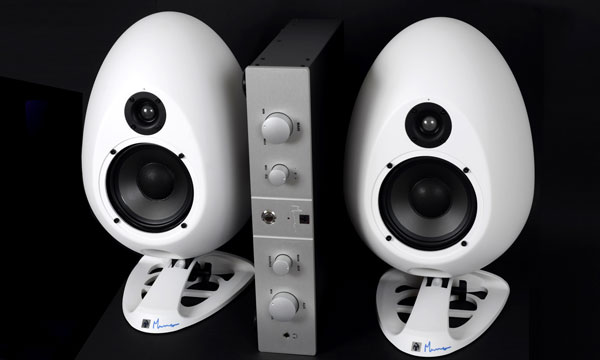
4. MunroSonic Egg 150 Monitoring System
Up there as contenders for most unusual speaker design, the MunroSonic Egg range of monitoring systems lives up to its name, in that it consists of a pair of uniquely egg-shaped passive speakers driven by a dedicated external analogue power amp that comes as part of the package, along with two high-quality, 3m cables to connect it all up. There is, naturally, a good reason for this departure from the norm – the company’s literature states that ‘the traditional wooden box has been replaced by a scientifically proven, curved enclosure that virtually eliminates diffraction and resonant effects that distort and smear the original sound’.
Combined with the free-standing amp is a control unit that features source-select inputs, active analogue crossovers, LF and HF trim pot equalisation for room and location set-up compensation and a re-defined mid-band control to emulate the mid-range response of both Hi-Fi and NS10 type speakers. The egg-shaped driver units sit on purpose built ‘nests’ that allow flexible positioning in all directions, aided by blue guide LED’s above each tweeter to help you locate the ‘sweet spot’ when setting up. The nests also allow sufficient room for the downward-facing bass port to expel the necessary air.
MunroSonic Egg 150 Monitoring System – Specs:
Design: 2-way passve, with downward-facing bass port and external analogue power amp
Woofer: 165mm Polypropylene Cone
Tweeter: 25mm dome
Frequency response: 45Hz – 20kHz
Wattage: MF/LF 50W HF 50W
Compatible Sub? No
Check current price: Reverb.
5. Eve Audio SC204
The smallest monitor in Eve Audio’s product line, the SC204 combines a 4-inch honeyomb-structured driver with an AMT (Air Motion Transformer) ribbon tweeter of their own proprietary design that’s used throughout the whole Eve Audio range. RCA and XLR analogue inputs feed directly into Burr-Brown digital converters, and the signal is processed digitally before reaching the PWM Class-D digital amps that feed the drivers. Sophisticated stuff.
A unique addition is the front-mounted volume control – the sort of thing you’d normally expect to find on budget desktop computer monitors, except this knob controls a host of other features, including standby mode, filter selections, speaker symmetries, phase tweakings and even LED display intensity.
There’s a large rear rectangular port with smooth edges to extend the low-end response and minimise bass distortion, while the ribbon tweeter provides a crisp and detailed high end that’s bright without being harsh. All in all, these diminutive and affordable speakers punch way above their weight.
Eve Audio SC204 – Specs:
Design: 2-way active
Woofer: 4-inch cone
Tweeter: AMT RS1
Frequency response: 64Hz – 21kHz
Wattage: MF/LF 50W, HF 50W
Dimensions: 5.7 x 9.0 x 7.7″ (145 x 230 x 195mm)
Weight: 8.4lb (3.8kg)
Compatible Sub? Yes – Eve Audio TS107
Available from: Nova Distribution – 020 3589 2530
Web: www.eve-audio.com
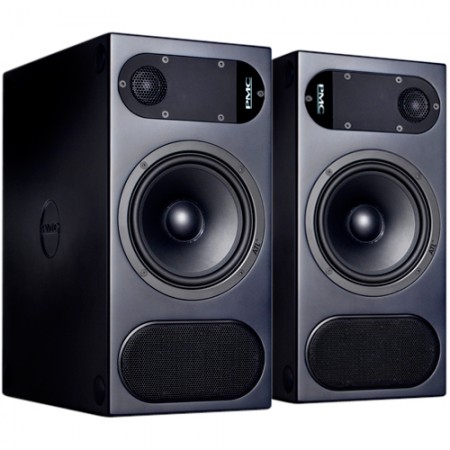
6. PMC twotwo 6
British manufacturer PMC aren’t just known for the excellent quality of their speakers, but also for the transmission line principle that lies at the core of their design philosophy. Their version is named ATL (Advanced Transmission Line) and, in the twotwo range, places the bass cone near one end of a long tunnel within the casing, lined with material that absorbs the high and low-mid frequencies radiating from the rear of the cone. The lowest frequencies emerge from the end of the tunnel via a port at the front that effectively acts as a second bass driver.
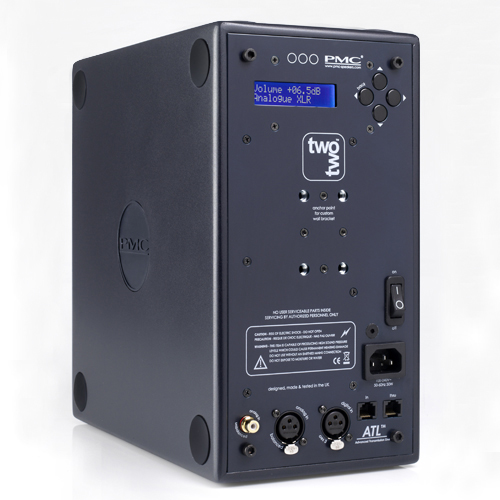 The twotwo range consists of three models – numbered 5, 6 and 8 after the size of the bass driver in each – and what sets them apart from their predecessors is the addition of DSP-based EQ, crossover and driver response adjustment, making them the only PMC nearfield monitors to feature EQ compensation apart from the range-topping AML series.
The twotwo range consists of three models – numbered 5, 6 and 8 after the size of the bass driver in each – and what sets them apart from their predecessors is the addition of DSP-based EQ, crossover and driver response adjustment, making them the only PMC nearfield monitors to feature EQ compensation apart from the range-topping AML series.
Throw in an LCD screen on the back to let you see what’s happening while you adjust the EQ settings, digital and analogue inputs and the ability to link monitors together with a Cat 5 ethernet cable that supplies duplicate EQ settings and audio to a second monitor and you have a class-leading package that can’t be ignored.
PMC twotwo 6 – Specs:
Design: 2-way active
Woofer: 6.5-inch cone
Tweeter: 27mm soft dome
Frequency response: 40Hz – 25kHz
Wattage: MF/LF 150W, class D, HF 50W, class D
Dimensions: 16” x 7.6 x 14.3” (406 x 194 x 364)
Weight: 18.5lb (8.4kg)
Compatible Sub? Yes – twotwo sub1 & twotwo sub2
Available from: HHB – 020 8962 5000
Web: www.pmc-speakers.com
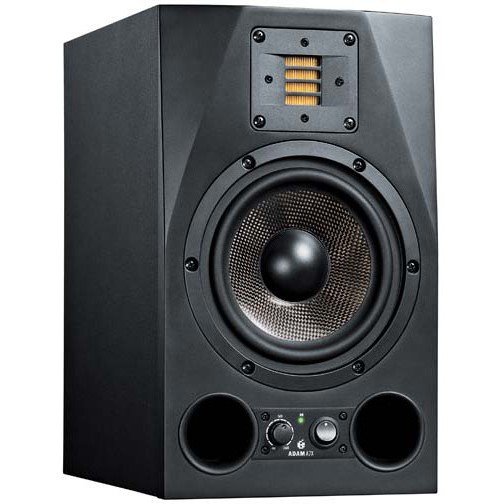
7. Adam A7x
Another brand that favours the ribbon tweeter design, Adam Audio’s version is known as the X-ART (short for eXtended Accelerating Ribbon Technology), so-called because of a claimed flat frequency response that extends up to an amazing 50kHz. Why would you want to go that far beyond the range of human hearing you might ask? Good question, but the idea behind the design is to achieve detailed, uncompressed highs and upper mids without being tiring over long listening periods, and it has to be said that the A7x reproduces transients with incredible clarity, creating an extremely precise sound. Universally accepted as one of the best monitors on the market, the A7x improves on the original A7 model in almost every aspect, from that updated tweeter and new amps to a redesigned bass and midrange driver. There’s an additional bass port on the front, and round the back you have controls for tweeter level and high and low shelf filters.
Adam A7x – Specs:
Design: 2-way active
Woofer: 7-inch Carbon/Rohacell/Glass Fibre cone
Tweeter: X-ART (Equivalent diameter 2”)
Frequency response: 42Hz – 50kHz
Wattage: MF/LF 100W PWM, HF 50W class AB
Dimensions: 13.5 x 8 x 11″ (337 x 201 x 280mm)
Weight: 20.3 lb (9,2 kg)
Compatible Sub? Adam Audio Sub 10 Mk 2
Check current price: Guitar Center, Musician’s Friend.
8. ATC SCM25A
The SCM25A is ATC’s first ever compact three-way active studio monitor, but their previously available large / midfield designs have garnered accolades from every corner of the the music-making world, building a reputation for precise and detailed reproduction across the whole frequency spectrum at any volume level. The SCM25A continues the family tradition, and at a whopping 30kg per cabinet, you know you’re dealing with a quality product as soon as you (and three burly mates) lift it from the box!
Design-wise, it’s one of the few on the market to offer a choice between two different approaches to loudspeaker cabinet design. There’s a large port vent on the side panel adjacent to the woofer that can be plugged with a dense foam bung, transforming the speaker from a reflex design into a sealed cabinet design if needed.
With a clean and natural bottom end, the mid-range clarity shines through thanks to that renowned ATC soft-dome mid-range driver, and the highs are honest and detailed, allowing for easy analysis and precise adjustment of mixes without being overly fatiguing or clinical. There’s no escaping the fact that the SCM25A is one of the more expensive monitors on the market for its size, but the accuracy and quality of its performance really does justify the extra expense.
ATC SCM25A – Specs:
Design: 3-way active, with side-mounted bass port
Woofer: hand-built 7˝/164mm short-coil carbon-paper cone
Mid: hand-built 3˝/75mm soft-dome
Tweeter: 25mm neodymium soft-dome
Frequency response: 47Hz – 22kHz
Wattage: LF 150W, MF 60W, HF 25W
Dimensions: 10.4 x 16.9 x 114.5” (264 x 430x 369mm)
Weight: 66lb (30kg)
Compatible Sub? No
Web: www.atcloudspeakers.co.uk
9. Barefoot Sound MicroMain 45
For those lucky souls where budget is no object, Barefoot Sound’s range of high-end monitors have to be high on the list of considerations. Barefoot are kind of the monitor equivalent of the Rolls Royce, but nestling down near the more affordable end of their product spectrum (although still not exactly cheap at £6k a pair) the MicroMain 45’s are a stripped-down version of the flagship MiniMain12’s. These three-way active monitors are probably equally suited to midfield and nearfield use owing to their size – and the 8-inch bass driver, twin 2.5-inch midrange cones and 1-inch ring radiator tweeter certainly get the job done.
Barefoot’s approach to monitor speaker design has always been to deliver outstanding sound quality, wide dynamic range and bass extension at every stage of the audio production process, and the MM45 sums up that philosophy in a nutshell. Now though, Barefoot speakers offer a range of preset EQ options in the shape of MEME voice emulation technology, meaning that, with just the flick of a switch, you can get your monitors to emulate the sound of sweetened ‘Hi-Fi’ speakers or, with the ‘Old School’ setting, the classic Yamaha NS10M. Amazing.
Barefoot Sound MicroMain 45 – Specs:
Design: 3-way active
Woofer: 8-inch aluminium cone
Mid: 2 x 2.5-inch aluminium cones
Tweeter: 1-inch ring radiator
Frequency response: 40Hz – 45kHz
Wattage: LF 250W, MF 180W, HF 180W
Dimensions: 11 x 15.5 x 11” (279 x 394 x 279mm)
Weight: 37.5lb (17kg)
Compatible Sub? Barefoot MicroSub
Available from: KMR Audio +44 (0) 20 8445 2446
Web: www.kmraudio.com, www.barefootsound.com
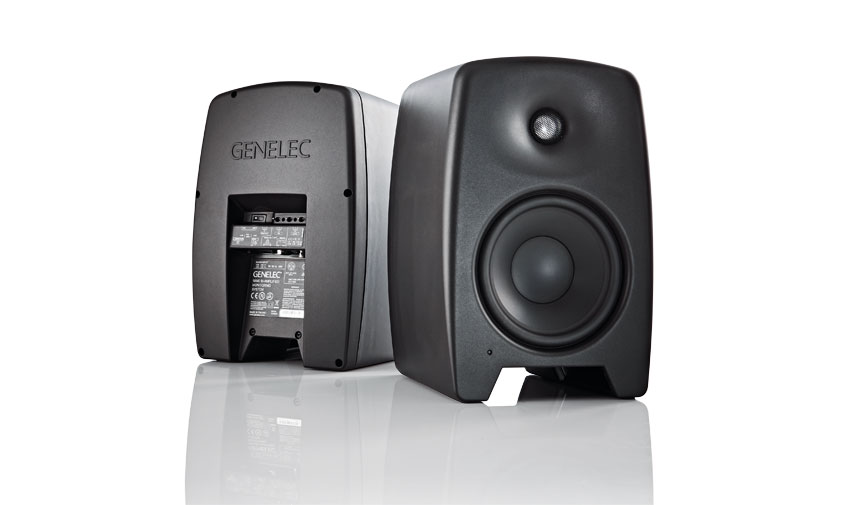
10. Genelec M040
Finnish company Genelec have a fine studio monitor pedigree, stretching back to the early 80’s when their large, wall-mounted designs were the speaker of choice for a huge number of professional recording studios worldwide. Still going strong, it’s now possible to get the Genelec name in your own studio for a fraction of the price of their hefty ancestors with the brilliant, small and mighty M040 (and even smaller M030).
Genelec have thrown an impressive number of acronyms into the design of the M040. There’s the Directivity Control Waveguide (DCW™), which ensures flatness of the overall frequency response, the Laminar Integrated Port (LIP™) moulded into the cabinet to aid faithful bass reproduction, Intelligent Signal Sensing (ISS) that automatically enters standby mode if no signal is detected for 30 minutes, and the Natural Composite Enclosure (NCE™), which refers to the environmentally-friendly makeup of the cabinet itself. Elsewhere, you’ll find simple-to-use room response compensation controls, in the form of dip switches, mounted on the rear of the cabinet, to tailor the response to any acoustic environment.
Genelec M040 – Specs:
Design: 2-way active, ported
Woofer: 6.5-inch cone
Tweeter: 1-inch metal dome
Frequency response: 44Hz – 21kHz
Wattage: MF/LF 80W, class D, HF 50W, class D
Dimensions: 13.3 x 9.3 x 9″ (337 x 235 x 229mm)
Weight: 15.4lb (7.4kg)
Compatible Sub? Genelec 7040A
Check current price: Guitar Center, Musician’s Friend.
If you find this article helpful, don’t forget to check out the previous one in this series, our 10 Best Audio Interfaces – Essential Buyers Guide.



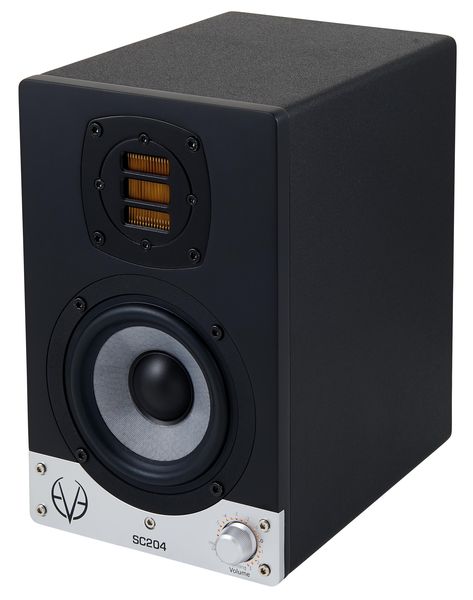
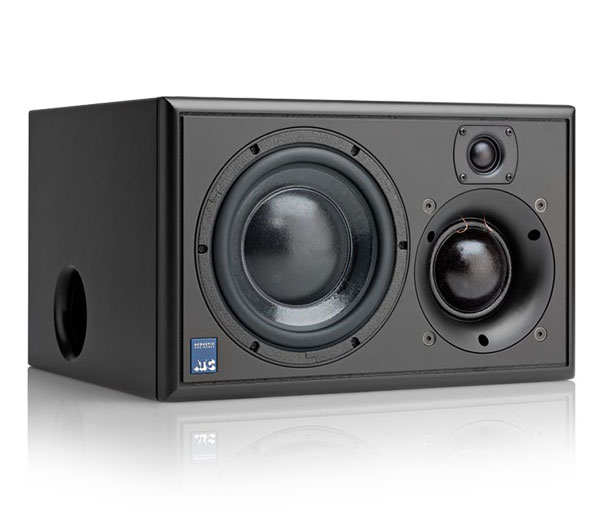
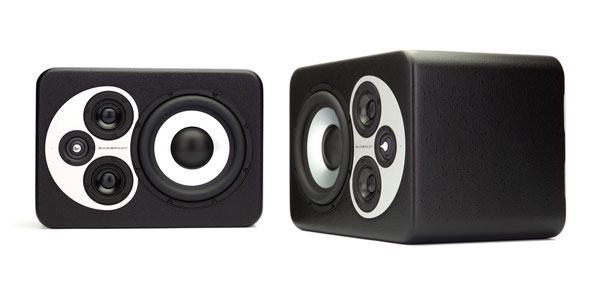
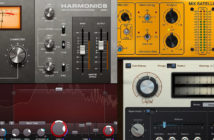
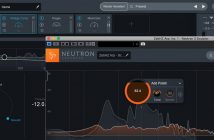
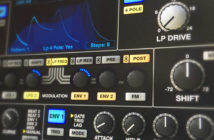
3 Comments
Great Review!
Good article, but just a clartification:
The Egg 150 monitors are NOT passive, they’re active speakers. The crossover is active but external, housed with the 4 amplifiers into that metal chassis.
It’s a common misconception since practically all the active monitors come with the amps and crossovers inside the cabinet…the ubication of the crossover doesn’t change anything in regards of passive or active operation. The fact that it uses one amp for each driver and a quick look into the amp/crossover/eq circuit chassis reveals the active crossover.
I have M040 and focal solo6 be and hedd type 07…
i just want to say M040 is incredible….accurate frequency response and imaging…and the best speaker translation